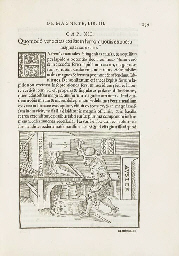Title: De Magnete, Magneticisque Corporibus, et de Magno Magnete Tellure; Physiologia Noua, Plurimis & Argumentis, & Experimentis Demonstrata Author: Gilbert, William (Guilielmi Gilberti Colcestrensis, medici Londinensis) Place: Londini Publisher: Excudebat Petrus Short Date: 1600 Description: [16], 240 pp. (*8, A-V6). With 1 folding engraved plate; woodcuts in the text; woodcut initials, head- and tail-pieces; woodcut device on title-page; woodcut coat of arms on verso of title-page. (Folio) 29.5x19 cm. (11½x7½"), modern vellum binding using an old manuscript antiphonal leaf, custom clamshell cloth case. First Edition. First edition of the "first major English scientific treatise based on experimental methods of research" (PMM). The title translates into English as "On the Magnet and Magnetic Bodies, and on That Great Magnet the Earth," and from his experiments, Gilbert arrived at the remarkable conclusion that the Earth was magnetic and that this was why the compass pointed north. It was with Gilbert that the modern development of electricity and magnetism truly starts. Gilbert made the claim that gravity was due to the same force and he believed that this held the Moon in orbit around the Earth, and while incorrect by modern standards, this claim was still far closer to the truth than the ancient Aristotelian theory, which held that the heavenly bodies consist of a special fifth element which naturally moves in circles, while the earthly elements naturally move downward. Johannes Kepler accepted Gilbert's theory and used it as a working basis for his famous laws of planetary motion. In De Magnete, Gilbert also studied static electricity produced by amber. Amber is called elektron in Greek, and electrum in Latin, so Gilbert decided to refer to the phenomenon by the adjective electricus, giving rise to the modern terms "electric" and "electricity". De Magnete was influential not only because of the inherent interest of its subject matter, but also for the rigorous way in which Gilbert described his experiments and his rejection of ancient theories of magnetism. PMM 107. Lot Amendments Condition: Light foxing, faint dampstain in margins of a few leaves at front; repair on reverse of folding plate; still a near fine copy in a fine modern binding. Item number: 259835
Title: De Magnete, Magneticisque Corporibus, et de Magno Magnete Tellure; Physiologia Noua, Plurimis & Argumentis, & Experimentis Demonstrata Author: Gilbert, William (Guilielmi Gilberti Colcestrensis, medici Londinensis) Place: Londini Publisher: Excudebat Petrus Short Date: 1600 Description: [16], 240 pp. (*8, A-V6). With 1 folding engraved plate; woodcuts in the text; woodcut initials, head- and tail-pieces; woodcut device on title-page; woodcut coat of arms on verso of title-page. (Folio) 29.5x19 cm. (11½x7½"), modern vellum binding using an old manuscript antiphonal leaf, custom clamshell cloth case. First Edition. First edition of the "first major English scientific treatise based on experimental methods of research" (PMM). The title translates into English as "On the Magnet and Magnetic Bodies, and on That Great Magnet the Earth," and from his experiments, Gilbert arrived at the remarkable conclusion that the Earth was magnetic and that this was why the compass pointed north. It was with Gilbert that the modern development of electricity and magnetism truly starts. Gilbert made the claim that gravity was due to the same force and he believed that this held the Moon in orbit around the Earth, and while incorrect by modern standards, this claim was still far closer to the truth than the ancient Aristotelian theory, which held that the heavenly bodies consist of a special fifth element which naturally moves in circles, while the earthly elements naturally move downward. Johannes Kepler accepted Gilbert's theory and used it as a working basis for his famous laws of planetary motion. In De Magnete, Gilbert also studied static electricity produced by amber. Amber is called elektron in Greek, and electrum in Latin, so Gilbert decided to refer to the phenomenon by the adjective electricus, giving rise to the modern terms "electric" and "electricity". De Magnete was influential not only because of the inherent interest of its subject matter, but also for the rigorous way in which Gilbert described his experiments and his rejection of ancient theories of magnetism. PMM 107. Lot Amendments Condition: Light foxing, faint dampstain in margins of a few leaves at front; repair on reverse of folding plate; still a near fine copy in a fine modern binding. Item number: 259835


.jpg?height=400)
.jpg)

.jpg)









Testen Sie LotSearch und seine Premium-Features 7 Tage - ohne Kosten!
Lassen Sie sich automatisch über neue Objekte in kommenden Auktionen benachrichtigen.
Suchauftrag anlegen